Nash Holos: Marla Raucher Osborn on her Rohatyn restoration project. (Part 2)
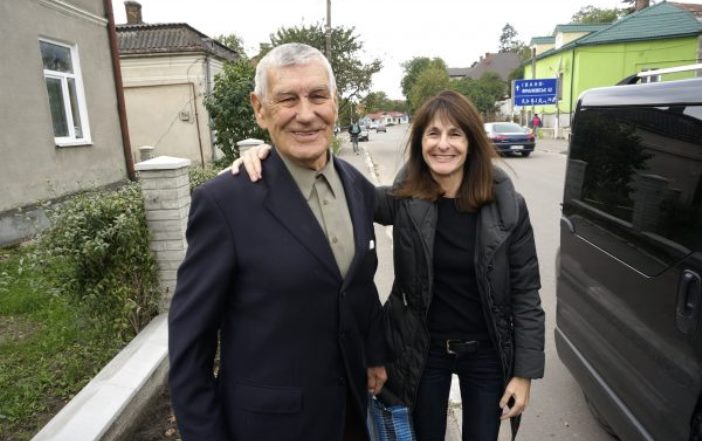
In the last episode of Ukrainian Jewish Heritage, we spoke with Marla Raucher Osborn, who discovered her Jewish roots a few years ago in the western Ukrainian city of Rohatyn. Shortly thereafter, she and her husband left their home in California and relocated to Lviv, in western Ukraine, where they now run an NGO called Rohatyn Jewish Heritage. This NGO, or non-government organization, is dedicated to restoring Rohatyn’s centuries-old Jewish heritage, which was almost completely obliterated by the Nazis during the Holocaust. In the last episode of Ukrainian Jewish Heritage, Marla shared with us the reasons behind her driving passion for this work, a bit about the centuries-old history of Rohatyn’s Jewish community, and some of the different projects she and her organization are tackling. She also introduced us to one of the people who plays a key role in her organization.
In this episode, part 2 of our interview with Marla Raucher Osborn, we ‘ll find out more about this man so critical to her work. Marla will also provide a bit more detail about the challenges her Rohatyn restoration project faces, in particular Jewish cemeteries, and locating headstones—or what is left of the countless headstones that had been desecrated and vandalized by the Nazis and later the Soviet authorities.
Pawlina: Marla, tell us about Mykhailo—you mentioned, the people of Rohatyn working with you and with Jewish heritage community outside of Ukraine. Tell us about Mykhailo Vorobets.
Marla: A very special person. He is 83 years old. In fact we spoke about the Jewish descendants coming in 1998, working with the city to erect memorials. He was part of that, he was there. He was in touch with several of the descendants that worked on the creation of these memorials, and he continues to be there. At this point he is a retired school teacher, which is a very common characteristic I have found in towns; oftentimes the person who is the carrier of memory (for lack of a better word) is a former school teacher. He has written a number of books. He continues to lecture to students about the multi-ethnic pre-war population of Rohatyn with the Jewish component very prevalent. Even last week he lectured to some students about this. He has been for the last six years since we created Rohatyn Jewish Heritage, he has been our key contact in the city. He doesn’t speak English which is another reason we always bring an interpreter with us. It was Mykhailo Vorobets that Renata met with at least once if not more times during her visits. I would like to add that, on his own for over 25 years at this point, he has been planting flowers at the mass grave sites, caring for the cemeteries in conjunction with the city, bringing Jewish headstones back to the cemetery if they have been found in town, and he continues to be our liaison with the city and the residents when Jewish headstones are uncovered in town for coordinating their return to the Jewish cemetery.
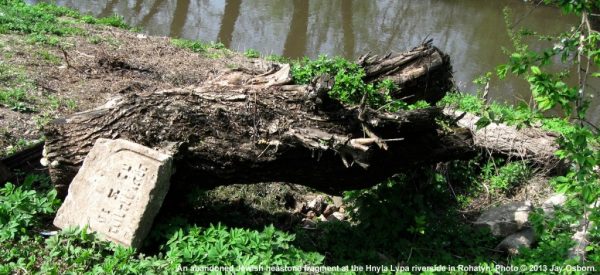
Pawlina: So tell us about the headstones, that is your main project, right?
Marla: Yeah. What to say about it? I am not a practicing religious Jew; but the first time I saw a Jewish headstone on the banks of the river in Rohatyn, it changed me. To see a Jewish headstone with Hebrew writing on it in a place other than a Jewish cemetery is a changing experience. It speaks volumes. The headstones were our first encounter when we returned for that second visit to Rohatyn in 2011. Mr. Vorobets showed us headstones that had been pulled out of a road that had been opened for maintenance work. Headstones get pulled out of private gardens, or as we walk the streets of Rohatyn with him, because everyone knows him, and feels comfortable speaking with him; it is very common on trips for people to come out of their houses, and motion for us to come into the backyard, because they have a Jewish headstone they have been keeping, but they were not sure what it was, what to do with it. At this point six years on I would say between social media and the many, many trips we make to Rohatyn in the course of a year, and also speaking with students and working with the church, the Ukrainian church in town, residents know to contact Mr. Vorobets if they know of a Jewish headstone that is not in the cemetery. So we really have what I think is a wonderful momentum that is finally going after six years.
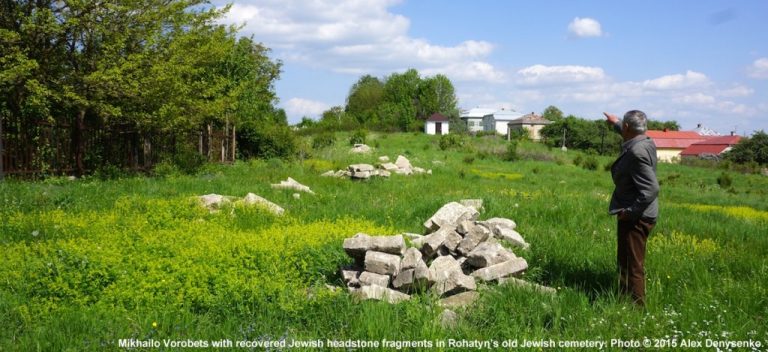


Pawlina: You mentioned something about the places these headstones are found… gardens and things. These were used by Nazis and then Soviets as well; they used these as concrete or building materials?
Marla: Right. Again… the Holocaust is not just about the destruction of people, but destruction of culture, and what are the signs of culture but the physical embodiments of culture. Synagogues, cemeteries, schools, that sort of thing. One of the first things the Nazis did was to destroy the Jewish cemeteries by taking the headstones, breaking them into workable sizes, and using them to pave roads. The roads in Rohatyn that we have heard about from memoirs and testimonies that were paved with Jewish headstones are largely known. So most of the time when headstones are discovered in roads in Rohatyn it is not a big surprise, because we have either uncovered them in the past, or we have heard about these roads having been paved. We have had a couple of surprises in terms of private gardens. Only then working with Mr. Vorobets ,we’ll research and discover this garden once had a house that a Gestapo member maybe lived in during the occupation; or in the case of one area in Rohatyn, the Gestapo headquarters had the parking lot paved with Jewish headstones. So some of the same areas keep coming up, though periodically a headstone may be returned to Mr. Vorobets and we may not necessarily know where it was originally found.
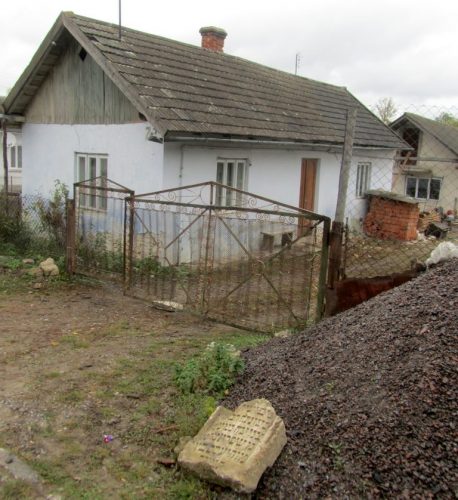
Pawlina: So of course you won’t find them all.
Marla: I think this project is going to outlive me because I started thinking; Jews were in Rohatyn for at least 350 years. The old Jewish cemetery was active until the 1920’s. You are talking probably 10,000 headstones when it was finally full and closed and the second cemetery was opened. So you know, somewhere in town there are an awful lot of headstones that have not been recovered because to date, we have recovered somewhere between 500-600 fragments, few of which are complete headstones. So it is a project that is going to go on well beyond my lifetime. I need to keep that in mind, we need to keep that in mind. It is a project that will continue.
Pawlina: Wow, that is a legacy if I ever heard one. I think that is absolutely remarkable. Are there towns in Ukraine… kind of following your model? Are they following in your footsteps in getting inspiration in doing something similar?
Marla: You know there are actually thousands of towns that started long before I did. These days with social media I don’t think a week goes by when some project isn’t brought to my attention and I find that this project has been going on a lot longer than Rohatyn Jewish Heritage. You have many, many examples in western Ukraine which I can speak best about. They are often times organically initiated. In other words they’re projects that start up in town that don’t even have the involvement of the Jewish diaspora. And they sometimes approach me as a bridge to the Jewish diaspora to get them involved in these projects, and to highlight that there is a memorial that is being built, or headstones that have been found in this town, or somebody wants to do a project that puts a plaque on a former building that was a synagogue. These are projects that Ukrainians in the towns are starting up. And it would be wonderful if Jewish decedents would join them in a partnership.
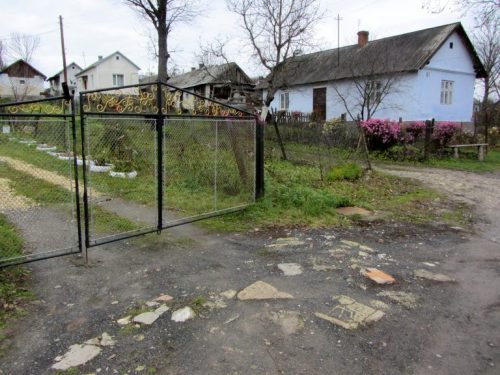
Pawlina: Interesting to hear you say that. Since it was the Jewish diaspora outside of Ukraine that started it in Rohatyn.
Marla: Yeah except truly, Mr. Vorobets has been caring for these sites long before I ever came; he was involved with these projects 15 years before I even made my first trip to Rohatyn. So I don’t even think I am a good example to inspire other people because this stuff has been going on, it just hasn’t been publicised. Not as well as it has been publicised in other countries, for instance, Poland; just on the other side of the border where you have similar projects. But at this point Poland has institutions and organisations in place that involve the Jewish diaspora in these projects, to the extent they want to get involved. Ukraine is still lagging a little bit behind and for many Americans, and I am sure you know also for Canadians: Ukraine just seems like another planet. So little is known about it and… it is just not as familiar. Of course for those of us who have roots in Galicia, if you have a grandparent from Galicia, your town may very well today be in Ukraine, not in Poland. So it’s an education process on both sides.
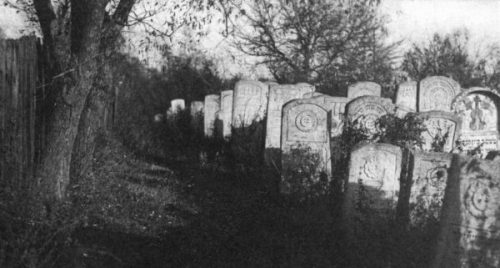
Pawlina: It is important for you to do this and it is great that you are doing it. You have been on Facebook. Actually for me, I have been following you since Renata [Hanynets] brought Rohatyn and your page to our attention. So this project that you started with your husband Jay; it is an NGO now that is devoted to Rohatyn restoring Ukrainian Jewish heritage and community, or maybe heritage, I am not sure if there is enough people to even have a community anymore like they did in years past. But at least you are restoring what’s left, and hopefully building on that. You are telling the world about it. You have many projects, we talked about the headstones and almost coming to half an hour so we could talk for another hour at least I am sure.
Marla: At least!
Pawlina: Maybe we should talk about that after we are done after this interview and make arrangements to find out more about what you are doing, because you have different projects. Just give us a list of the projects…
Marla: Absolutely. There is a new regional museum that is opening up in Rohatyn. It is a museum on Ukrainian regional history of the Opillia area, which Rohatyn is the major town. It is going as I mentioned to have a component of a permanent exhibit on the other ethnicities that once lived in the town. So we are working with the museum on a permanent exhibit about the Jewish history of Rohatyn. We have spoken several times with teachers and students who are interested in Rohatyn, learning about the Jewish history. Also several students believe or not, have expressed interested in learning Hebrew, how to bring Hebrew lessons to Rohatyn, which is something I need to investigate further.
Pawlina: That will be fun with you learning Ukrainian. Do you know Hebrew?
Marla: No I do not.
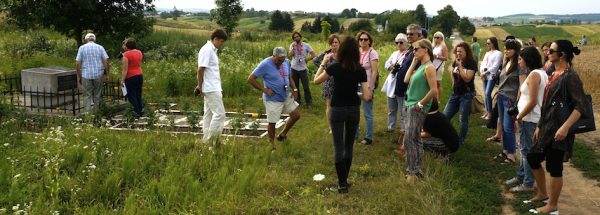
Pawlina: There you go, another project for you.
Marla: That question absolutely hit me unexpectedly, when a couple of students and teachers asked about that. But in addition to that; they are interested in doing projects that involve studying and learning about the history of specific buildings in town, especially buildings on the market square where there were pre-war Jewish businesses. Some of these students are interested in interviewing grandparents and great grandparents about their memories about the Jewish community. They are interested in making walking tour maps. You see this in other towns in the region. Buczacz has a very active heritage project that is sort of centered around the writer Agnon—they have built walking tours around to see where he lived and wrote etc. Of course Lviv has several heritage projects. It would be really wonderful I think to even consider Rohatyn joining forces with other cities in Ivano-Frankivsk or Lviv Oblast, creating a sort of a heritage tour. And the heritage tour could have a component that is Jewish heritage, Ukrainian heritage, Polish heritage. You get a lot of Poles coming over here wanting to visit their towns and understand where their Polish cemeteries are, their Polish churches are. In many cases, like Jewish heritage there is not a Jewish or Polish community there anymore; so the Ukrainian current population lives with the Polish churches, the Polish cemeteries, the Jewish synagogues, surviving buildings and cemeteries. So there is a rich, rich history here with a great potential for heritage tourism. And I would really like to get more involved with that, because I think that is something that benefits not just visitors; like Jewish visitors, but benefits the town and the residents as well.
Pawlina: And I think the visitors probably the most. Going away with a completely different view of the world, history and their place in the world.
Marla: Most certainly, but again I think it would be a wonderful experience…for example to bring Jewish students over here to sit down with Ukrainian students one on one, and talk. There are English courses that are taught in Rohatyn, I have met with some of the students so it is not out of the realm of possibility that they could sit and talk about what is of interest to them and they would discover they are very similar. They may live in different countries, they may practice different religions, but they have a lot of the same interests, a lot of the same curiosities. I think it is a wonderful way of bridging differences in countries, generations etc. As I say, if I could bring somebody over here with me, a trip to Rohatyn would turn them around. Because it is one thing to talk about it on social media and in genealogy-based discussion groups, it is another thing to walk the streets of your grandparents.
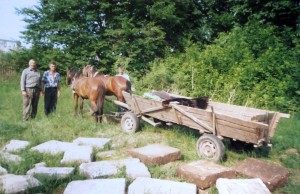
Pawlina: Absolutely. Maybe I will get you to bring me over!
Marla: I want you over here. Are you kidding? I would love it!
Pawlina: I would love to as well, something else for us to talk about later one.
Marla: Fantastic!
Pawlina: One of your projects is a public education campaign.
Marla: Yes.
Pawlina: And tell us a little bit about that, how you are planning to do that. Obviously talking on Nash Holos is one, and being on Facebook is another.
Marla: Yeah to the extent we can write articles or participate in conferences etc. But Rohatyn Jewish Heritage as you mentioned now is officially a Ukrainian NGO. And in fact I am here to say as of today, we officially have an agreement of a memorandum of understanding signed with the city of Rohatyn, to cooperate on future heritage projects. It’s now official. And we have a website which is www.rohatynjewishheritage.org, which by the end of this year should be 100% bi-lingual; English and Ukrainian. The website is not only a place for news about our visits and projects, and what is going on in town, but also we are very actively working on a timeline of the Jewish community. We want to have it eventually interactive with the Ukrainian Rohatyn community, so they can contribute the Ukrainian history. At some point I would love a Polish contribution so we can get a fuller picture of what the pre-war community was like. It is a way of also being exposed to genealogy, heritage, websites and links of events, projects, and other heritage activists on the internet. So it is a one-stop shop for anybody with roots in Rohatyn. And it’s continuing to change, and it will feature our projects, upcoming, past etc.
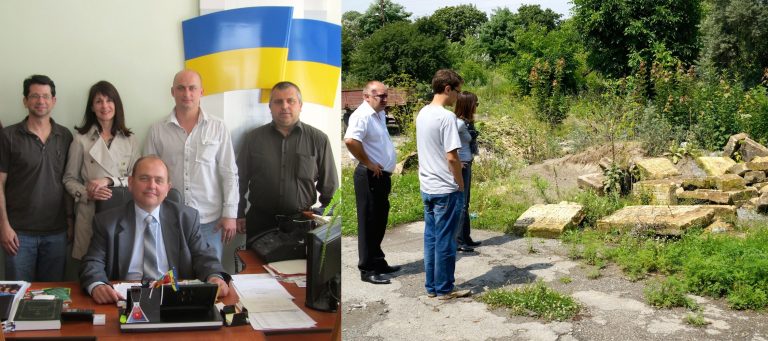
Pawlina: Wow that is a huge project, obviously your life’s work, right?
Marla: Yeah pretty much.
Pawlina: Well… so you probably can use help then. You’re looking for volunteers to help?
Marla: Volunteers … it’s tough because we are not set up for that. It really is just the two of us. We are actively working to partner with organisations. Right now we are speaking with an American Christian organisation about coming to Rohatyn next summer to professionally clean the old Jewish cemetery in preparation for our next big project, which be will hopefully using the headstones we have collected to create a memorial space. But generally the best way to help us is if you have roots in Rohatyn we of course want to hear from you. Otherwise the website, www.rohatynjewishheritage.org, certainly accepts donations. They are (for American citizens) tax deductable. And 100% of the donations go towards the projects themselves. Everything is very upfront and transparent in terms of what projects cost. Again we are not really set up to bring individual volunteers with us, but on the other hand, once in a while we need somebody to help us translate something from Hebrew or Polish or Ukrainian, and we reach out into the community, usually using Facebook, or to people we have met along the way here in Lviv who have worked with us on other projects.
Pawlina: Okay so for people interested in keeping track of what you are doing, and maybe planning a trip to Rohatyn, or giving information to others who would be interested in going, who have roots there or whatever. You have two main places online; your Facebook page and your website. And Rohatyn is spelled rohatyn…
Marla: Yes. It’s one word—www.rohatynjewishheritage.org.
Pawlina: And also just go on Facebook [and Google]?
Marla: Same thing.
Pawlina: Perfect.
Marla: Yep same thing, and there is a link from the website to Facebook as well.
Pawlina: Okay wonderful. Well… wow, you have your work cut out for you. Your life’s work as you said… wishing you all the best…in all the projects going forward.
Marla: Thank you! We very much appreciate the interview, because it is very rare for us to be able to bridge to the Ukrainian community with the non-Jewish community, so this is a wonderful outlet for us.
Pawlina: Well that is great, Marla. Thank you so much! All the best and we will talk to you again soon.
And that ends our special two-part interview with Marla Raucher Osborn of Rohatyn Jewish Heritage, a Ukrainian NGO dedicated to restoring the Jewish heritage of the Ukrainian city of Rohatyn.
Thank you for your time and attention. Щиро дякую!
Until next time, Shalom!
Listen to the program here.
Listen to part one of this interview here.
Ukrainian Jewish Heritage is brought to you by the Ukrainian Jewish Encounter (UJE), a privately funded multinational organization whose goal is to promote mutual understanding between Ukrainians and Jews. Transcripts and audio files of this and earlier broadcasts of Ukrainian Jewish Heritage are available at the UJE website and the Nash Holos website.
NOTE: The UJE does not necessarily endorse opinions expressed in articles and other materials published on its website and social media pages. Such materials are posted to promote discussion related to Ukrainian-Jewish interactions and relations. The website and social media pages will be places of information that reflect varied viewpoints.




















